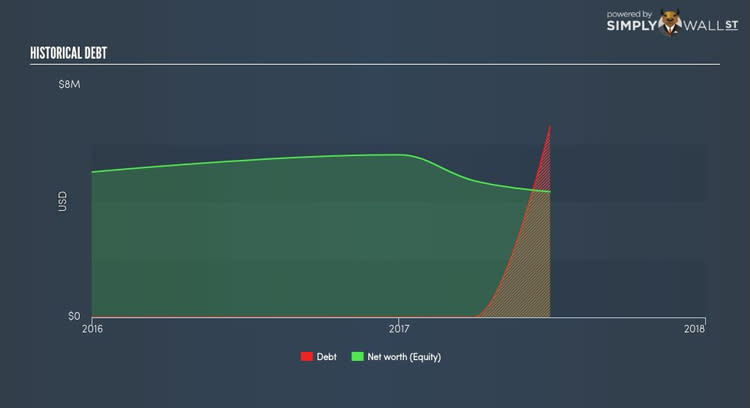Is Celcuity Inc’s (CELC) Balance Sheet Strong Enough To Weather A Storm?

Investors are always looking for growth in small-cap stocks like Celcuity Inc (NASDAQ:CELC), with a market cap of USD $193.80M. However, an important fact which most ignore is: how financially healthy is the company? Why is it important? A major downturn in the energy industry has resulted in over 150 companies going bankrupt and has put more than 100 on the verge of a collapse, primarily due to excessive debt. These factors make a basic understanding of a company’s financial position of utmost importance for a potential investor. Here are a few basic checks that are good enough to have a broad overview of the company’s financial strength. See our latest analysis for CELC
Does CELC generate an acceptable amount of cash through operations?
There are many headwinds that come unannounced, such as natural disasters and political turmoil, which can challenge a small business and its ability to adapt and recover. These catastrophes does not mean the company can stop servicing its debt obligations. We can test the impact of these adverse events by looking at whether cash from its current operations can pay back its current debt obligations. CELC’s recent operating cash flow was -0.56 times its debt within the past year. This means what CELC can generate on an annual basis, which is currently a negative value, does not cover what it actually owes its debtors in the near term. This raises a red flag, looking at CELC’s operations at this point in time.
Can CELC meet its short-term obligations with the cash in hand?
What about its commitments to other stakeholders such as payments to suppliers and employees? As cash flow from operation is hindered by adverse events, CELC may need to liquidate its short-term assets to meet these upcoming payments. We test for CELC’s ability to meet these needs by comparing its cash and short-term investments with current liabilities. Our analysis shows that CELC is able to meet its upcoming commitments with its cash and other short-term assets, which lessens our concerns for the company’s business operations should any unfavourable circumstances arise.
Is CELC’s level of debt at an acceptable level?
While ideally the debt-to equity ratio of a financially healthy company should be less than 40%, several factors such as industry life-cycle and economic conditions can result in a company raising a significant amount of debt. For CELC, the debt-to-equity ratio stands at above 100%, which indicates that the company is holding a high level of debt relative to its net worth. In the event of financial turmoil, the company may experience difficulty meeting interest and other debt obligations.
Next Steps:
Are you a shareholder? CELC’s debt and cash flow levels indicate room for improvement. Its cash flow coverage of less than a quarter of debt means that operating efficiency could be an issue. However, its high liquidity ensures the company will continue to operate smoothly should unfavourable circumstances arise. Given that its financial position may be different. I suggest keeping on top of market expectations for CELC’s future growth on our free analysis platform.
Are you a potential investor? With a high level of debt on its balance sheet, CELC could still be in a financially strong position if its cash flow also stacked up. However, this isn’t the case, and there’s room for CELC to increase its operational efficiency. Though, the company will be able to pay all of its upcoming liabilities from its current short-term assets. You should continue your analysis by taking a look at CELC’s past performance analysis on our free platform to conclude on CELC’s financial health.
To help readers see pass the short term volatility of the financial market, we aim to bring you a long-term focused research analysis purely driven by fundamental data. Note that our analysis does not factor in the latest price sensitive company announcements.
The author is an independent contributor and at the time of publication had no position in the stocks mentioned.

